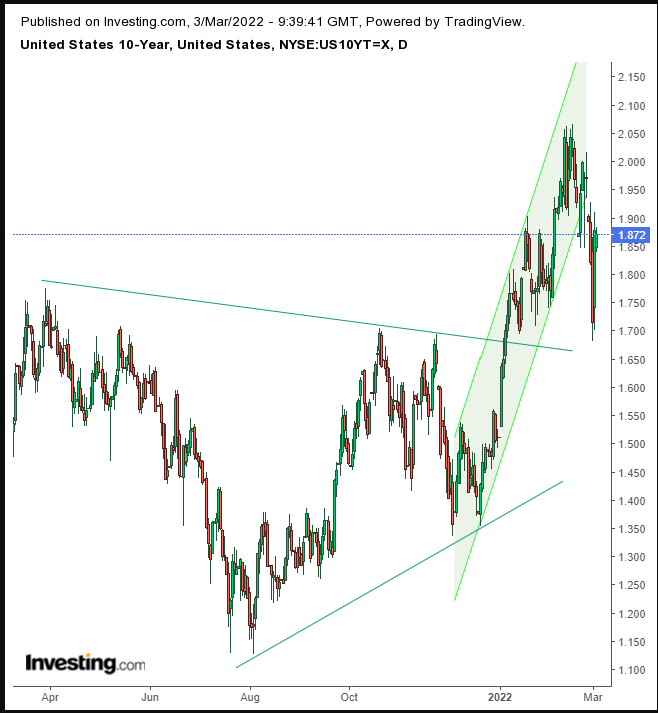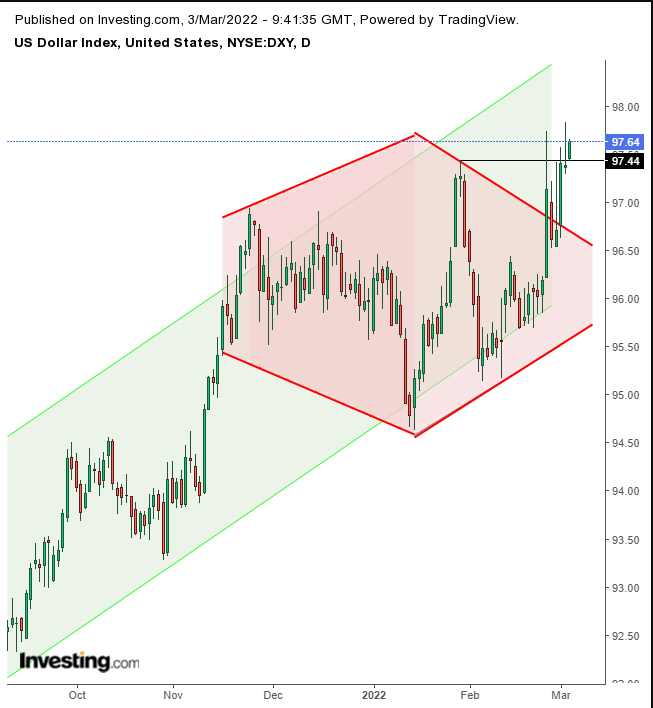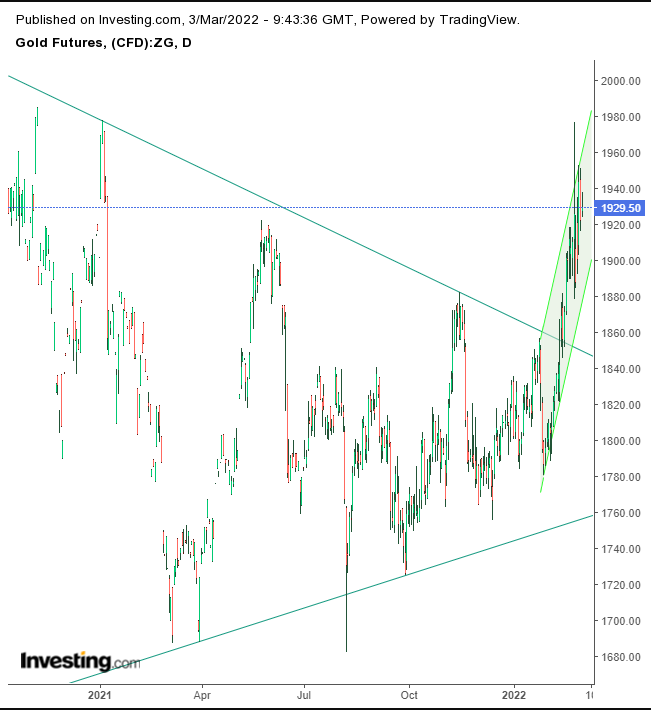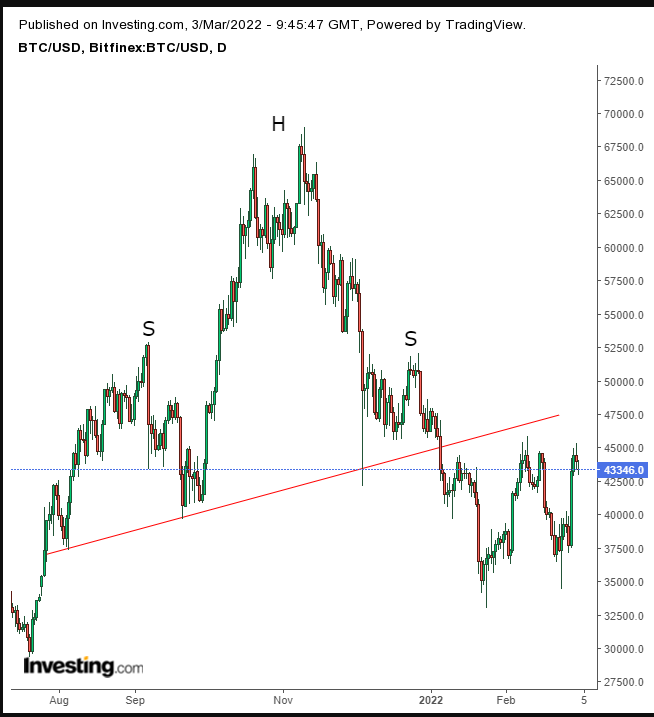- Oil and natural gas hit highs
- Metals extend a dramatic climb
- Dollar rallies
- Canadian Ivey PMI for February is announced on Friday.
- US unemployment rate for February is published on Friday.
- On Friday US nonfarm payrolls are printed.
- The STOXX 600 fell 0.1%
- Futures on the S&P 500 fell 0.1%
- Futures on the NASDAQ 100 fell 0.4%
- Futures on the Dow Jones Industrial Average were little changed
- The MSCI Asia Pacific Index fell 1.4%
- The MSCI Emerging Markets Index fell 0.7%
- The Dollar Index rose 0.1%
- The euro fell 0.2% to $1.1093
- The Japanese yen rose 0.2% to 115.75 per dollar
- The offshore yuan was little changed at 6.3224 per dollar
- The British pound fell 0.2% to $1.3370
- The yield on 10-year Treasuries declined one basis point to 1.86%
- Germany's 10-year yield rose to 0.049%
- Britain's 10-year yield advanced four basis points to 1.30%
- WTI jumped 3.32% to $113.91 a barrel
- Brent crude rose 1.89% to $115.50 a barrel
- Spot gold rose 0.2% to $1,932.01 an ounce
Key Events
On Thursday, US futures and European stocks retreated from Wednesday's rally, as surging commodity prices exacerbate the worst inflation in four decades. Contracts on the Dow Jones, S&P 500, NASDAQ, and Russell 2000 were all trading in the red today as investors believe rising raw material costs will force central banks to tighten policy to stabilize markets.
Bitcoin slipped for a second day.
Global Financial Affairs
Intermarket analysis, which examines the relationship between more than one asset class to ascertain the strength or weakness of the financial markets, shows that typically a bull market begins with rising bonds, accelerating stocks, and a rally in commodities.
The rationale: Investors buy into the safety of bonds when the equity market is bearish, which triggers a bull market in debt. This helps fuel a recovery in stocks, as lower yields drive investment in equities which helps to propel an economic recovery. Then, as the economy rebounds, spending increases and pushes commodity prices higher. However, the rising costs result in tightening monetary policy, which causes a recession.
This description is a textbook version of how it's supposed to go; in reality, things don't always play out so perfectly. However, all things being equal, surging commodity prices, when inflation is already at its highest level in over forty years, exacerbated by a global health crisis and now topped off by a war, dramatically increase the chance of a recession.
So far, the Russell 2000—which lists small caps and may be considered a riskier index than the broader benchmarks—has already entered a bear market, having fallen 20.92% between its Nov. 8 record peak and the Jan. 27 close. The NASDAQ 100 is also close to a 20% bear territory, having fallen 18.53% from its Nov. 19 record close.
The S&P 500 meanwhile has entered a correction, falling 11.91% between its Jan. 3 record and Feb. 23 bottom. Finally, the Dow Jones Industrial Average, home to safe, blue chip stocks, declined 9.97% between its Jan. 4 record and Feb. 23 low, nearing a correction phase as well, which is triggered by a 10% decline.
All four US futures for those underlying indices were trading in the red this morning, with NASDAQ contracts underperforming, as rising rates make stock prices more expensive. Contracts on the Dow fell the least, as investors tend to hold on to reliable meg-caps in times of trouble.
In Europe, the STOXX 600 slipped, with utilities leading the decline, while mining and energy-related companies outperformed as oil surged for the fourth consecutive day to as high as $116 a barrel, levels not seen since 2008. Natural gas prices have also rallied, jumping over 20% in the last few weeks. The incursion by Russia into Ukraine has altered the landscape for energy markets in just under two weeks but there are other considerations which may drive future price movements.
Commodities markets have been rallying as major corporates abandon Russia in droves to avoid sanctions levied against it. Zinc hit its highest level since 2007 as industrial metals have had a rapid run-up. European natural gas has also reached its highest ever level.
Investors increased holdings in Treasuries as well, including the 10-year note, pushing yields above a huge symmetrical triangle.

The rebound confirms the pattern's integrity and suggests yields will continue to rise, which will weigh on equities due to the increase in the cost of money as well as the attraction of a safer investment vehicle. This scenario agrees with our intermarket analysis which shows the increasing likelihood of a recession.
The dollar advanced to its highest level since June 2020.

Will it manage to close at these levels after repeatedly being pushed down before the close? If the USD closes above 98, it will have blown out a bearish diamond top.
Gold opened higher, paring yesterday's slump.

The yellow meal may revisit the bottom of its rising channel before continuing higher, after completing a symmetrical triangle in play throughout all of 2021 and into 2022.
Bitcoin opened lower.

The cryptocurrency had found resistance by the January and February highs, confirming the resistance of a neckline to an upsloping H&S top. We expect prices to test the $30,000 levels.
